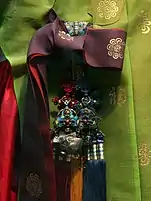Norigae
Norigae (hangul: 노리개) is a typical, traditional Korean accessory that is hung from a woman's jeogori goreum (coat strings) or hanbok chima (skirt) and so on.[1]
_with_Bats_LACMA_M.2000.15.213a-c.jpg.webp)
A norigae can be divided into 4 parts: the ddidon (hangul : 띠돈; hanja: 帶金) a hook (either a separate accessory or additional knots) to attach the norigae to the hanbok, the paemul (hangul : 패물) the main ornament of the norigae, the maedeup (hangul : 매듭) the knots of the norigae, and the sul (hangul : 술) the tassels.[2]
The norigae's function as a decorative pendant is both a good-luck charm hoped to bring something such as eternal youth, wealth or many sons (depending on its shape), as well as a fashion accessory. Usually, the norigae from the parents' or in-laws' home was passed down to descendants.[2]
Norigaes have various shapes derived from nature or from everyday life. They are divided into samjaks (hangul : 삼작; hanja: 三作) and danjaks (hangul : 단작; hanja: 單作), and samjaks can then be divided again into daesamjaks and sosamjaks. Daesamjaks and sosamjaks have the same form, but each one's paemul is different.[2]
History
The origins of the knotting tassel known as norigae can be dated back to the Joseon dynasty. The word norigae literally means “pretty and playful objects” signifying the use of the tassel charm. All women of different classes wore the norigae from queens to commoners. Different shapes and sizes signified the different occasions the norigae was worn to as well as which season to wear it in.[3]
The Composition
Norigae is composed by three basic parts: the main ornament, elaborate knots, the tassel on the lowest part. Norigae can be categorize to sizes, large, medium and small according to the person who wears the norigae or places at. For example, the norigae for infant will be much smaller one than adult's. In Joseon Dynasty, the king, Yeonsangun used the luxuriousness and sizes of norigae to classify the social rank of his women.[3]
Main Ornament
The main ornament for making norigae is usually using gold, silver, jewels, and precious stone.
The motifs of main ornament are cut down into 5 basic branches, such as animal, plants, daily objects, characters, and religious symbols. For example, the characters is auspicious Chinese character, like "壽" represents longevity. The religious symbols are motifs that represents Buddhism.[3]
Knots

Korean Knotting (maedeup) uses colored cord to braid into various shapes. The type of knot has to follow the design of main ornament. The big size of the main ornament parts will combine with small knots. The small main ornament comes along with large knots. The types of knots have to match the whole weight the norigae is going to be.[3]
Tassel
Tassel (sul) is using silk thread with colored and place at the lower parts.
Ttidon or a clasp means a metal hook in norigae. The purpose is to attach the norigae together and be able to hang on the clothes. There are a variety of shapes for ttidon, includes butterfly shape and typical circular shape or squared shape.[3]
References
| Wikimedia Commons has media related to Norigae. |
- "Use of Norigae". Global Encyclopedia / Daum.
- "Norigae". Korean Britannica Online. Archived from the original on 2012-04-15. Retrieved 2011-11-21.
- Lee, Kyung Ja (March 15, 2005). Norigae: Splendor of the Korean Costume. Ewha Woman’s University Press. ISBN 8973006185.